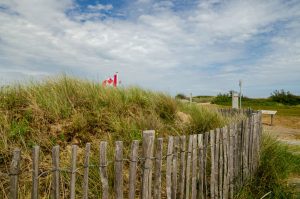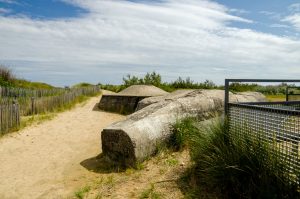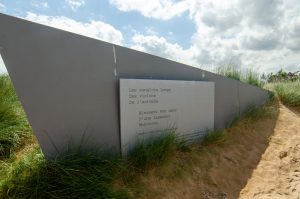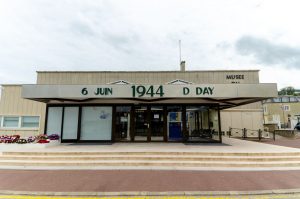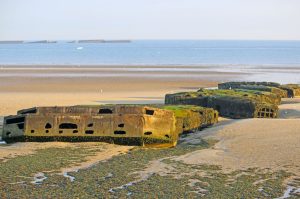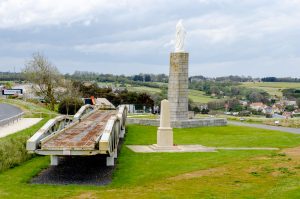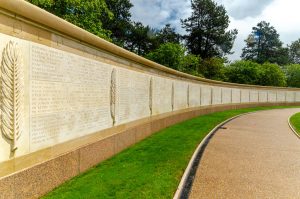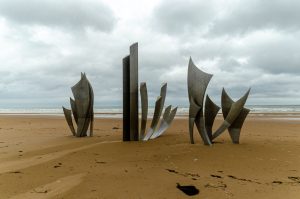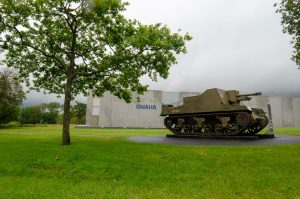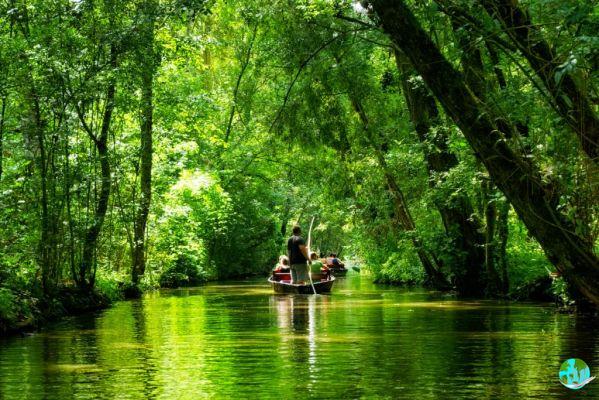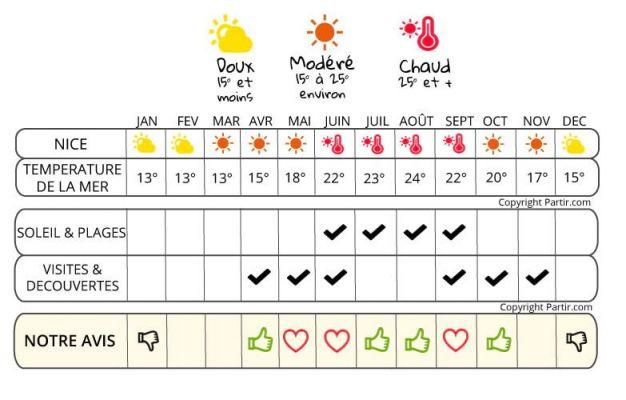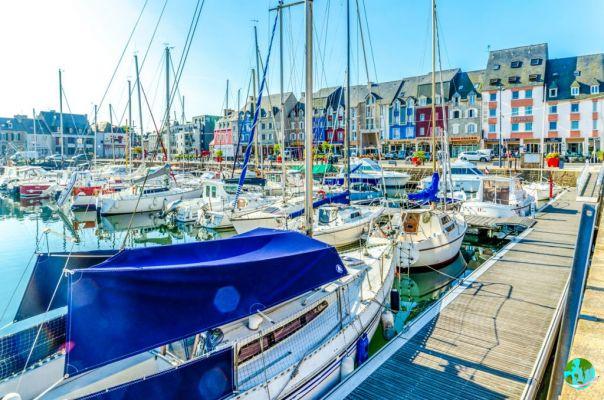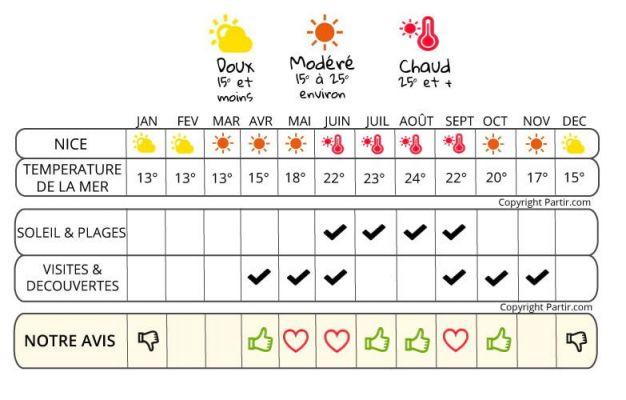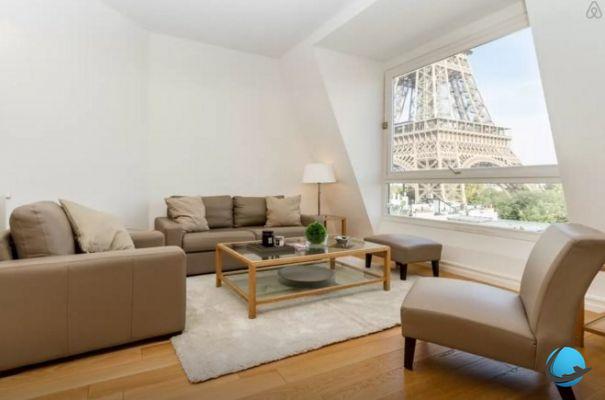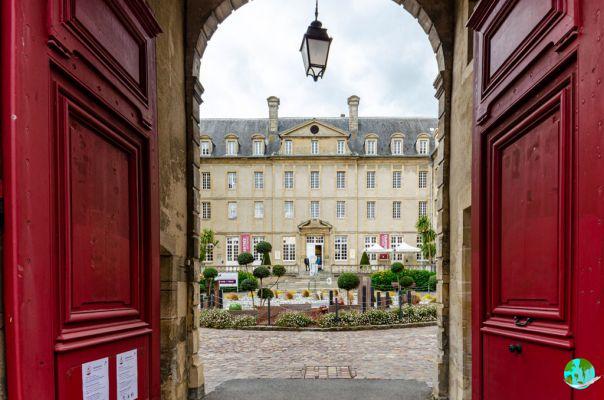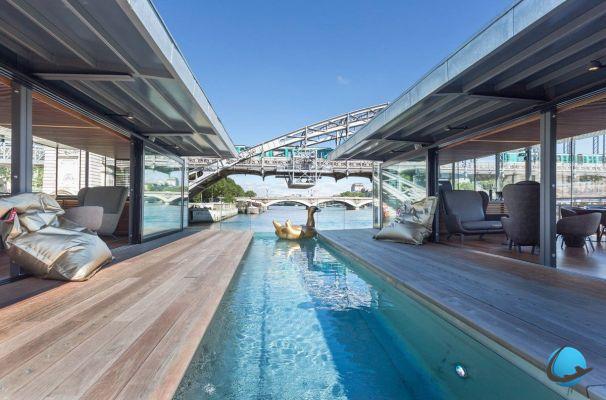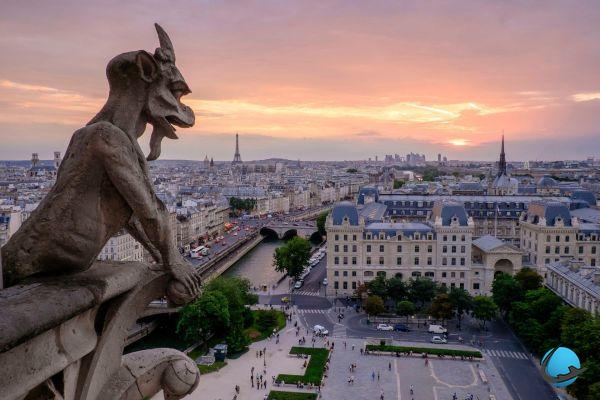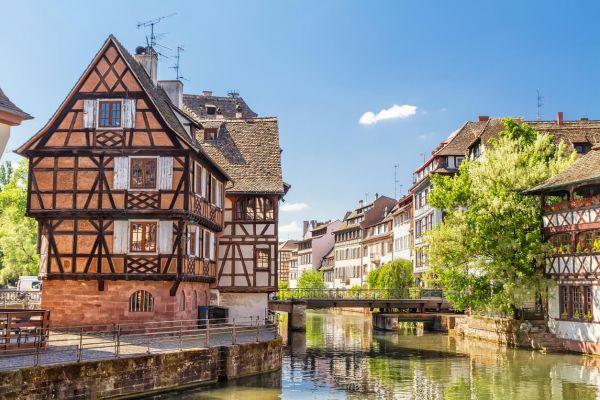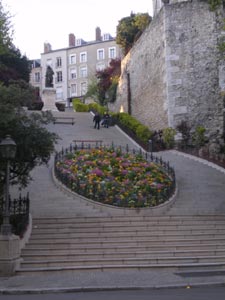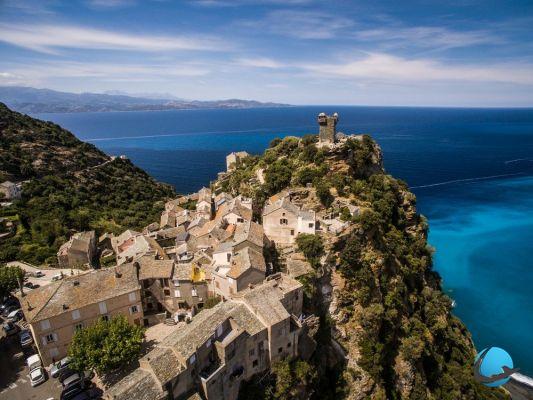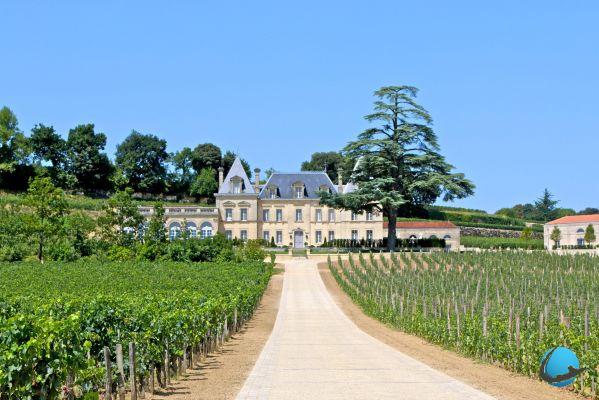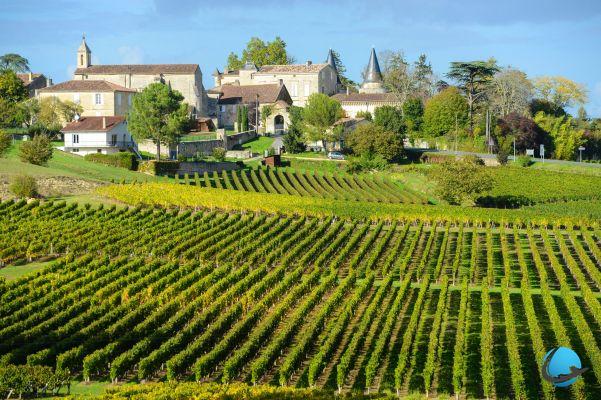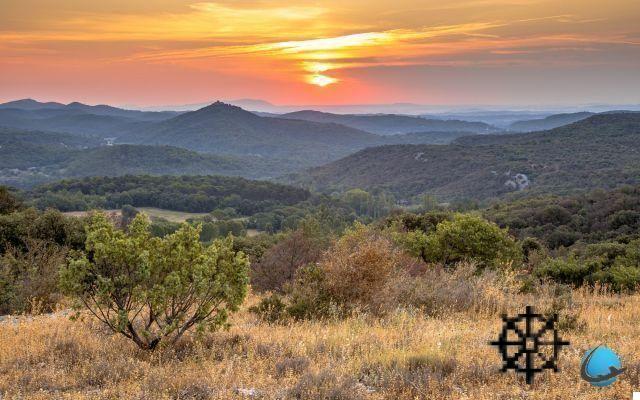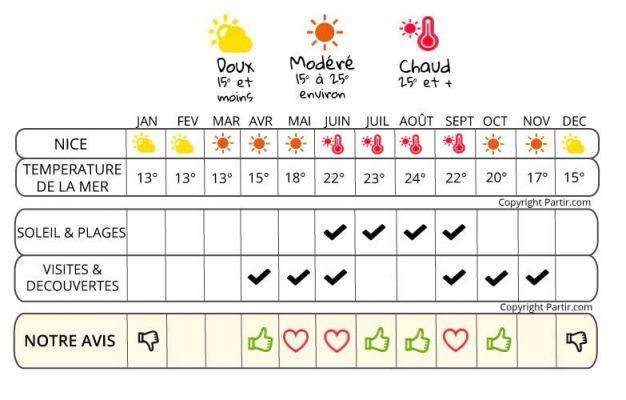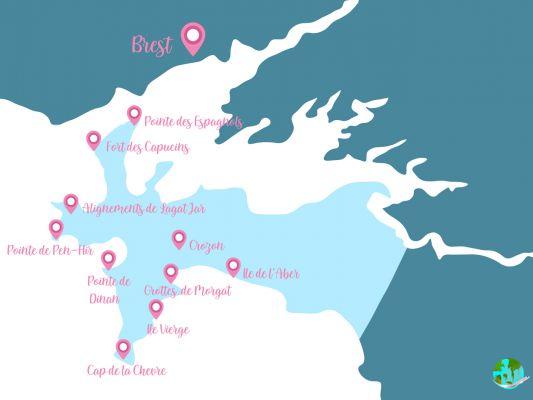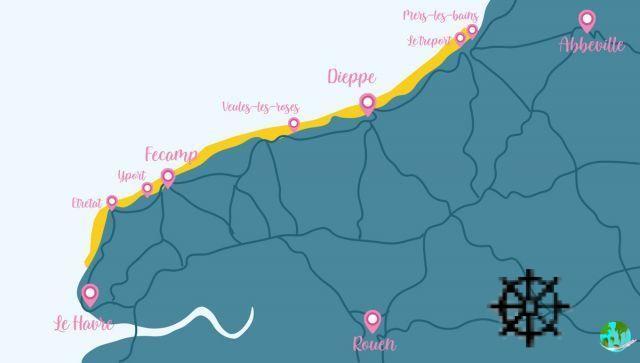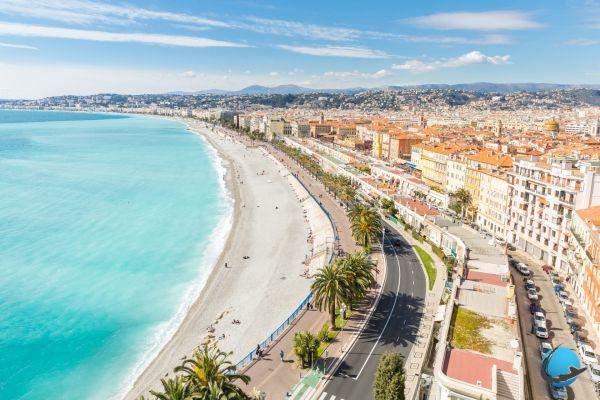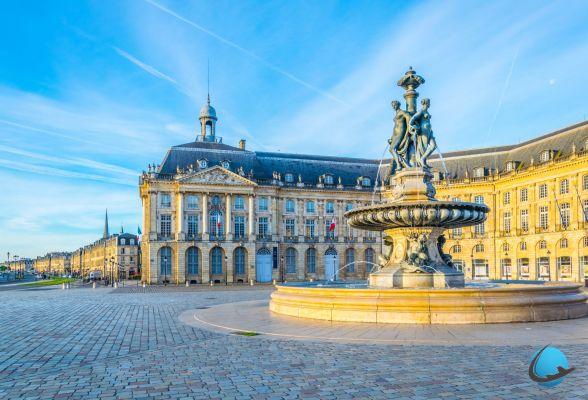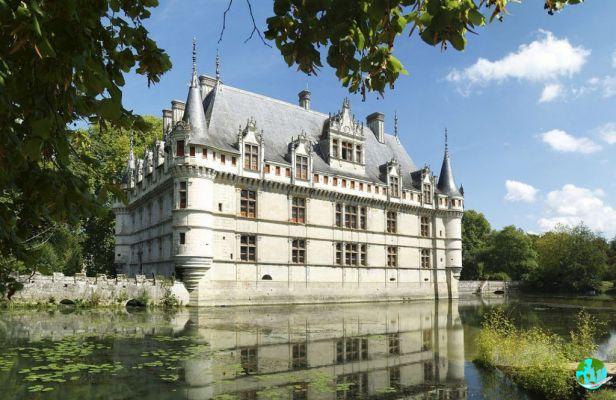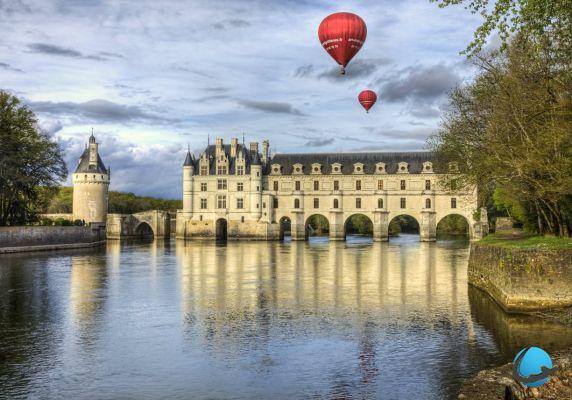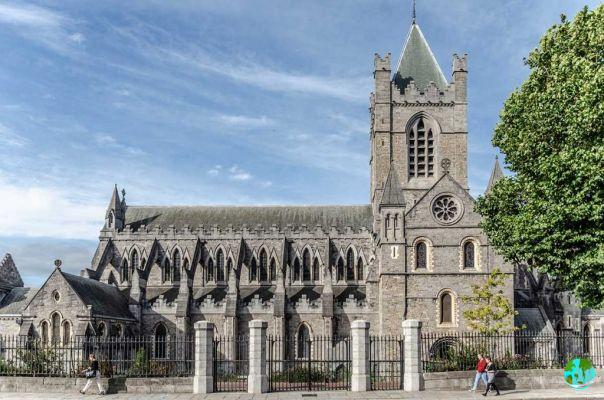Let's go to one of the most beautiful regions of France, Normandy, to discover one of the most important parts of its history: the landings. Indeed, on June 6, 1944, the history of France was played out on the beaches of Normandy.
Five in number, these beaches, now called the landing beaches, played a major role in the victory of the allies during the Second World War.
So I take you to visit the 5 landing beaches as well as many museums and cemeteries. We will see the significant places of the landing and their role in the course of events.
Summary
What are the landing beaches?
Which route to visit the landing beaches?
My opinion on my visit to the landing beaches
What are the landing beaches and how to visit them?
Let's start by reviewing the 5 beaches that were used to land on this morning of June 6, 1944. Two of them were used for the landing of American troops, two others for the landing of British troops and one for Canadian troops. .
What are the landing beaches?- Sword Beach
- Juno Beach
- Gold Beach
- Omaha Beach
- Utah Beach
> Sword Beach: British Sector
Sword Beach will therefore be the first of these five beaches that you will find when coming from the East.
This approximately 8km beach is located between the town of Ouistreham and that of Saint-Aubin-sur-Mer about 15 kilometers from the city of Caen.
On this beach, on June 6, 1944, the British troops landed as well as the troops of Free France from England. The Allied attack took place in front of Hermanville on a place called "La Brèche".
That day, 30 men landed here. The result of this attack is considered a success. "Only" 000 dead are to be deplored, which is relatively few in view of certain other beaches which we will discuss later.
One of the objectives of this attack was to connect the beach of Juno Beach which we will speak about right after. It was a success the next morning.
- Grand Bunker Museum of the Atlantic Wall
To find out more about this battle, go to the nearby town of Ouistreham and visit the "Grand Bunker Museum of the Atlantic Wall". This museum is a faithful recreation of the Atlantic Wall firing command post. An ideal place to visit to understand the functioning and the role of this building. - Commando N°4 Museum
Not far from the Grand Bunker Museum is another, smaller museum, the N°4 Commando Museum. This museum is dedicated to the French commando who also landed, with the British, on this beach in order to liberate Ouistreham.
> Juno Beach: Canadian Sector
Second landing beach (from the east), Juno Beach. It extends over 8 kilometers to the west of Sword Beach. Juno Beach is bounded to the east by the town of Saint-Aubin-sur-Mer and extends to Courseulles-sur-Mer to the west.
On this beach landed the 3rd Canadian Infantry Division. Their missions were to cut the Caen-Bayeux road axis as well as to take the Carpiquet aerodrome.
In addition, they had to reach the two beaches that surrounded Juno Beach: to the east Sword Beach, to the west Gold Beach.
Nearly 23 men (Canadian and British) landed on Juno Beach. On this day of June 000, 6, nearly 1944 of them lost their lives.
- Centre Juno Beach
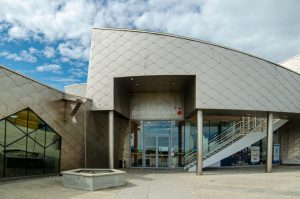 On Juno Beach, you can find two blockhouses and a museum, the Juno Beach Centre. Run by Canadians, the museum traces the history of the Juno Beach landings. You will find many period archives as well as objects picked up on the beach.
On Juno Beach, you can find two blockhouses and a museum, the Juno Beach Centre. Run by Canadians, the museum traces the history of the Juno Beach landings. You will find many period archives as well as objects picked up on the beach.
Besides the museum, it is also possible to follow a guided tour of the beach. I highly recommend this guided tour, organized by the Juno Center. You will have the opportunity to enter the two blockhouses located on the beach. A very good experience that will allow you to understand the organization of the landing in general but also the role of Canadian soldiers. Juno Center Official Site - Bény-sur-Mer Canadian Military Cemetery
A 10-minute drive from the Juno Center, inland is the Canadian War Cemetery. This cemetery is one of the largest in terms of the number of buried Canadian soldiers. There are 2049 graves.
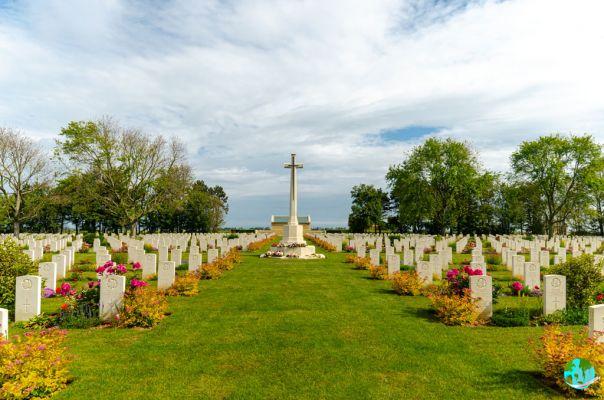
> Gold Beach: British Sector
Let's continue our tour of the landing beaches by going to the beach located just west of Juno Beach, Gold Beach. Gold Beach is a beach that was used by the British army on June 6, 44.
As with Juno Beach, the British Army's objective was to cut the Bayeux-Caen axis, liberate Bayeux and join the Canadian Army in the East.
25 men were landed on this beach, there are about 000 losses.
One of the most famous towns in this sector is that of Arromanches. On the beach of the city was built a huge artificial port, Mulberry, of which remains, even today, visible debris from the seaside.
The Arromanches Mulberry, named Mulberry B (for British), was the more important of the two artificial ports built.
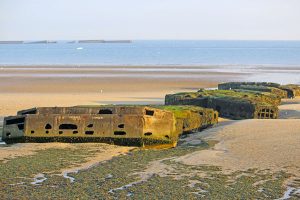 The Mulberrys are artificial ports created on June 7 using several elements aimed at breaking the waves and thus allowing the landing of military equipment.
The Mulberrys are artificial ports created on June 7 using several elements aimed at breaking the waves and thus allowing the landing of military equipment.These artificial harbors were created with cast-in-place ships, bombardons (cross-shaped metal caissons) and phoenix caissons.
The Mulberries were 2 in number, one in Arromanches, the Mulberry B for British, used for the beaches of Gold Beach and Juno Beach; the second, the Mulberry A for American, was used for the American beaches of Omaha and Utah Beach.
In total, more than 15 km of piers were built. These artificial ports made it possible to unload 400 vehicles and 000 million tons of material.
Between June 19 and 21, a major storm damaged the Mulberries: one was taken out of service, the other badly damaged.
> See the Mulberry Wikipedia file
- Gold Beach Museum of America
This small museum, located in Ver-sur-mer, between Courseulles-sur-Mer and Arromanches, is divided into 2 parts. One traces the landing of the British on the beach of Gold Beach, the other traces the history of the first airmail connection between France and the United States. - Arromanches Landing Museum
The Arromanches landing museum traces the history of the construction of the artificial port of Arromanches, the Mulberry B. An astonishing construction and a turbulent history on the program. The ideal place to learn more about this installation built the day after the landings. Official website of the Arromanches museum - Cinema Arromanches 360°
Just before arriving in Arromanches (coming from the East), is the Cinema Arromanches 360°. A circular cinema in which a 20-minute film is projected: “The 100 Days of Normandy”. This film traces the history of the landing. It is both built with archival images as well as with recent images of the surroundings.
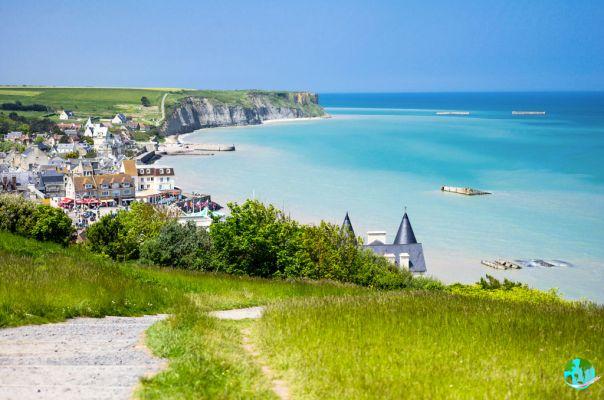
> Omaha Beach: American Sector
Omaha Beach is certainly the most famous of the five landing beaches. Sadly nicknamed Bloody Omaha in connection with the very heavy losses suffered by the allies, Omaha Beach is the most visited of the beaches in Normandy.
Omaha Beach saw the landing of two American divisions, nearly 35 men. 000 of them fell on June 2 under German fire.
In view of the heavy American losses, it is quite logical that the surroundings of Omaha beach host various museums, but above all one of the largest American military cemeteries in France.
Not far from Omaha beach is the Pointe du Hoc, a place fortified by the Germans that was heavily bombarded and remained as it was.
The heavy losses of the allies on Omaha beach follow a chain of unforeseen events.
First of all, the naval and air attacks which struck the various German positions on the Normandy coast were much less effective in the Omaha sector, leaving the Germans in a position of strength.
On June 6, a violent wind hit Omaha beach, pushing the Allied boats against the obstacles installed by the Germans.
Moreover, the accesses to Omaha beach were particularly well defended by the German troops.
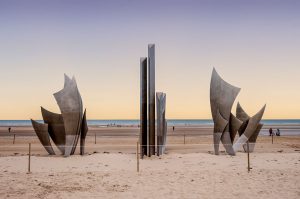 Statue "The Brave"
Statue "The Brave"
Erected on the occasion of the 60th anniversary of the landing, June 6, 2004, “Les Braves” are a set of 3 sculptures, “Debout la liberté! surrounded by "Wings of Hope" and "Wings of Brotherhood". Located on Omaha beach, in the town of Saint Laurent sur Mer, these sculptures are the work of the French Anilore BANON.- Battery of Longues-sur-Mer
Located in the city of Longues-sur-Mer, between the beaches of Gold Beach and Omaha Beach, the battery of Longues-sur-mer, now classified as a historic monument, is one of the gun batteries of the wall of the Atlantic. - Musée Big Red One
The Big Red One museum is a museum located in Colleville-sur-mer dedicated to the 1st American infantry division which landed on Omaha beach on June 6, 1944. You will find there many period pieces collected during the years. - D-Day Omaha Museum
The Omaha D-Day Museum is also located in Colleville-sur-mer, not far from the beach. It offers an exhibition of many period objects inside its American military building, but also outside for the most imposing pieces. - Omaha Beach Memorial Museum
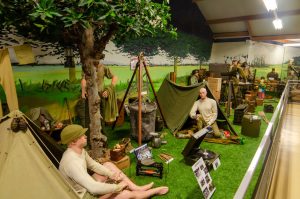 The Omaha Beach Memorial Museum is THE museum not to be missed in Omaha. Located 200 m from the “Les Braves” sculpture in Colleville-sur-mer, this museum also exhibits many period pieces, photos and personal objects. Scenes have been reconstructed using mannequins that help us understand life on the battlefields.
The Omaha Beach Memorial Museum is THE museum not to be missed in Omaha. Located 200 m from the “Les Braves” sculpture in Colleville-sur-mer, this museum also exhibits many period pieces, photos and personal objects. Scenes have been reconstructed using mannequins that help us understand life on the battlefields.
A film is also offered with, in part, images from the period which make us live the important moments of the landing.
In the parking lot, you cannot miss the imposing Sherman tank. Omaha Beach Memorial Museum Official Site - Overlord Museum
Located just opposite the Normandy American Cemetery, which we will discuss a little later, the Overlord Museum is one of the most recent D-Day museums. Inaugurated in 2013, this museum was created thanks to the Leloup family. Indeed, they exhibit more than 10 objects related to the Battle of Normandy. Personal effects of soldiers but also tanks or planes both German and having belonged to the allies. - Normandy American Cemetery
Just under 5km from the center of Colleville-sur-mer is the Normandy American Cemetery. This American military cemetery, one of the largest, houses more than 9 graves. A huge carefully maintained space granted, for life, to the United States by the French state.
In addition to the tombs, it is also this imposing memorial in the shape of a semi-circle dedicated to the missing soldiers that will amaze you. A place not to be missed. - The tip of Hoc
Located slightly after Omaha Beach, in the direction of Utah Beach, Pointe du Hoc is a battlefield that has remained as it is. One of the main points of German defense. Today, you can walk through the shell holes witnessing the intensity of the shelling.
225 rangers climbed the cliff to neutralize this German position, only 90 survived. - La Cambe German Cemetery
Continuing your route from East to West, between the village of La Cambe and Osmanville, you will find one of the largest German military cemeteries. Over 21 soldiers are buried here. Around this garden were planted 000 maple trees, symbolizing peace.
> Utah Beach: American Sector
Utah Beach is the westernmost beach of the 5 landing beaches. This is located on the other side of the mouth of the Vire, in the department of Manche, on the east coast of the tip of Cotentin.
This beach, about 5 km long, was one of the most strategic given its proximity to Cherbourg. Surrounded by swamps, this beach was considered unsuitable for a landing by the Germans, which explains the little resistance found by the American soldiers on June 6 and therefore the little loss suffered.
Indeed, out of 32 soldiers landed that day, mainly soldiers from the 000th American infantry division, only 4 of them were injured or killed.
The day before the landing, paratroopers were sent to the area. It is also not far from Utah Beach that is the famous town of Sainte-Mère-Eglise and its famous bell tower which saw a parachutist cling to it.
- Utah Beach, landing museum
On the very beach of Utah Beach, in a former German Bunker, is the Utah Beach landing museum. A museum that retraces the events that took place that day on Utah Beach with numerous archive documents, models and maps as well as a film.
You will also find in this museum, a real B26 bomber. A canopy offering a panoramic view of Utah Beach has also been installed in the Bunker. - Sainte-Mere-Eglise
Located a few kilometers from Utah Beach, take a trip to Saint-Mère-Eglise. Take a look at its church, of course, and look up at its steeple. A dummy was placed on top of it in memory of the soldier who clung to it the day before the landing.
Enter this church and take a look at the stained glass windows of the church dedicated to the landing. - Crisbecq Battery Museum
This museum, created in 2004, takes place in the middle of one of the most important German batteries in the region. This covered an area stretching from Saint-Vaast-la-Hougue in the north to Pointe du Hoc in the east.
A path, through trenches, will make you discover the 22 bunkers which constituted this battery. Some are empty, others are furnished with period pieces and aim to present life in the battery during the war.
Utah Beach et Omaha Beach : these names were chosen by Commander Bradley who led the American landing on these two beaches. He chooses the name of the towns of origin of the commanders directing the operations on each of these beaches.
Sword Beach et Gold Beach : these names were chosen by the British Montgomery, who decided to call these beaches after fish names: goldfish, Goldfish and Espadon, Swordfish.
Juno Beach : as far as this beach is concerned, it was the canadians who decided on the name. At first it was also to be called by the name of a marine species, the jellyfish: Jellyfish. Jelly (without the "fish") meaning "jelly", this name was not retained.
After discussion, it was finally the name of Lieutenant-Colonel Dawnay's wife who was chosen: Juno.
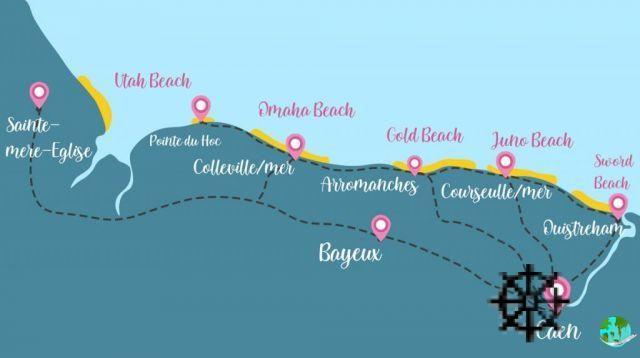
Geographical location of the landing beaches
Where to sleep to visit the landing beaches?The question of housing near the landing beaches will inevitably arise. The offer is relatively important around the beaches, either in the main cities of the region which are Caen and Bayeux but also closer to the beaches around Courseulles-sur-Mer, Arromanches or Colleville-sur-Mer.
To find out more about the accommodation offers, I invite you to read our article dedicated to accommodation around the landing beaches.
We have made a selection of the best hotels, lodges and even campsites. Where to sleep near the landing beaches?
Which route to visit the landing beaches?
The landing beaches are an essential stopover during a stay in Normandy. To take full advantage of the many activities, museums and other visits available around the beaches, we advise you to spend between 3 and 5 days there. By visiting the landing beaches, you will pass near certain places which are worth a look but which do not necessarily have a link with the Normandy landings. This is for example the case of Bayeux, where we strongly advise you to stop.
We will offer you here 2 different itineraries to visit the landing beaches: one of 3 days, the other of 5 days.
- 3 day itinerary
- 5 day itinerary
- Visit the landing beaches in 1 day
Visit the landing beaches in 3 days: Itinerary
This first route will take us from the city of Caen to Colleville-sur-Mer. We will discover 3 landing beaches there: Juno Beach, Gold Beach and Omaha Beach.
A detour via Bayeux will be considered.
| Day 1: From Caen to Courseulles-sur-mer (Juno Beach) Our day begins in Caen with a visit to the Caen memorial. Then, direction Courseulles-sur-mer for the visit of the Juno Beach Center. Visit of the Caen Memorial The Caen memorial is none other than the most visited museum in France outside the Paris region. This one is devoted to the war and devotes an important part to the Second World War and in particular to the landing of the allies. You can book your tickets online by clicking here. Centre Juno Beach A museum dedicated to the history of the Canadian forces landed on June 6 on Juno Beach. Finding accommodation near Courseulles-sur-mer |
| Day 2: From Courseulles-sur-mer to Bayeux (via Arromanches, Gold Beach) At the beginning of the 2nd day, the morning will be dedicated to the discovery of Gold Beach and Arromanches. Several museums are worth visiting. Arromanches 360° A panoramic cinema in which the film “Les 100 jours de Normandie” (20 minutes) is shown. Nearby is an exhibit of items salvaged from the Mulberry B. D-Day Museum A museum dedicated to the history of the Mulberry B located just in front of the town of Arromanches. The rest of the day will be devoted to visiting Bayeux: its city center, its cathedral and its museums, in particular the Bayeux Tapestry Museum. |
| Day 3: From Bayeux to Colleville-sur-Mer (Omaha Beach) This last day will be devoted to visiting Omaha Beach and its surroundings. Several museums are worth visiting as well as the unmissable Normandy American Cemetery. Don't miss the beach where "Les Braves" is located, an astonishing sculpture in homage to the victims of the landing. Omaha Beach Museums Omaha Beach Memorial Museum, Omaha D-Day Museum or the Overlord Museum, refer to the “Omaha Beach” section of this article and choose the museum(s) to visit. Find accommodation near Omaha Beach |
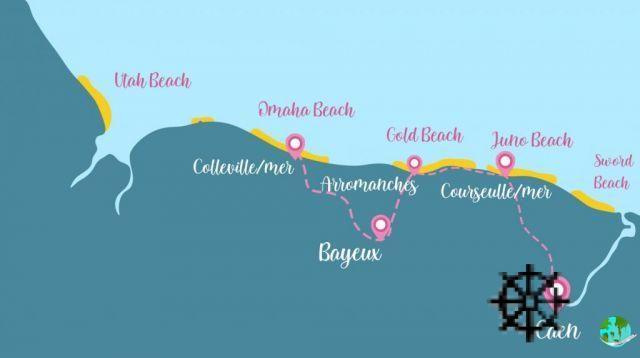
Itinerary to visit the landing beaches in 3 days
Visit the landing beaches in 5 days: itinerary
Our 5-day itinerary repeats the 3-day itinerary but adds a few additional stages. Similar stages will not be detailed in the 5-day itinerary.
| Day 1: Caen This first day will be dedicated to the visit of Caen, its center, its churches, Saint-Pierre and Saint-Etienne, or its castle. Don't miss a visit to the Mémorial de Caen, one of the most visited museums outside of Paris. You can book your tickets online by clicking here. |
| Day 2: From Juno Beach to Gold Beach A day devoted to visiting two beaches in Normandy, Juno Beach, in the Canadian sector with, among other things, a visit to the Juno Beach Centre. Direction Gold Beach with a stop at Arromanches and a visit to these museums. |
| Day 3: Bayeux As detailed in the 3-day itinerary, Bayeux is a friendly city where various visits are possible, in particular that of the Bayeux Tapestry Museum. A free guided tour of the city is also possible. |
| Day 4: Omaha Beach A day dedicated to Omaha beach and its surroundings. You can go to the beach section of Omaha Beach to learn more about the many museums to visit. Don't miss the Normandy American Cemetery. If time permits, take the road towards the West to make a stop at the Pointe du Hoc, then at the German cemetery of La Cambe. |
| Jour 5 : Utah Beach A last day dedicated to the discovery of Utah Beach and its landing museum. A visit to Sainte-Mère-Eglise is also a must-do when visiting the Utah Beach area. |
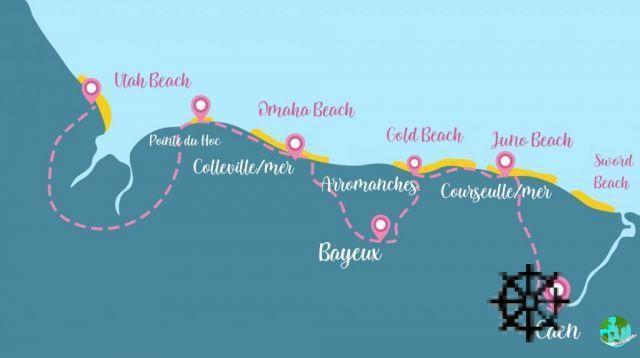
Itinerary to visit the landing beaches in 5 days
Visit the landing beaches in 1 day
A day is obviously very little to discover the 5 beaches of Normandy. However, if you don't have more time, I advise you to opt for a guided excursion to the landing beaches, departing from Caen (approximately 6 hours) or Paris (approximately 12 hours).
An excursion that will take you to discover the main places of the region.
The visit begins in Caen, at the memorial, then heads for the town of Arromanches where the remains of Mulberry B are located, the artificial port built just after the landings.
The excursion continues towards Colleville-sur-Mer to discover Omaha Beach and its surroundings, then Pointe du Hoc.
My opinion on my visit to the landing beaches
Visiting the landing beaches in Normandy is for me one of the must-sees to visit in France. Normandy is one of the regions that we must discover for many reasons, but the visit of the landing beaches is in itself a sufficient reason. Visiting these beaches, museums and cemeteries is one of the best ways to understand the events that took place there on June 6, 1944. The history of our country being directly linked to these events, this is for me one of the few visits to make without hesitation.




